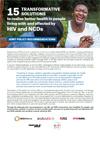
 <
< | Publicado | 25 de julio de 2022 |
|---|---|
| Autor | |
| Descargar |
Descripción
People living with HIV are at an increased risk of noncommunicable disease (NCD) comorbidities, including cardiovascular diseases such as hypertension, depression, diabetes, cervical cancer, and several other cancers and NCDs. Given that the global population of people living with HIV is living longer thanks to increased access and uptake of antiretroviral treatment, the risk of NCDs will only increase. Integration of prevention, diagnosis and care of NCDs with HIV services is increasingly important for achieving Universal Health Coverage (UHC). It will also improve HIV and health outcomes, well-being and quality of life of people living with and at risk of HIV around the world.
In the 2021 Political Declaration on HIV and AIDS, United Nations Member States pledged, among other things, to ensure that 90% of people living with, at risk of and affected by HIV have access to NCD prevention and care services, including for mental health, by 2025. Specifically, the target commits governments to: “Investing in robust, resilient, equitable and publicly funded systems for health and social protection systems that provide 90% of people living with, at risk of and affected by HIV with people-centred and context-specific integrated services for HIV and other communicable diseases, NCDs, sexual and reproductive health care and gender-based violence, mental health, palliative care, treatment of alcohol dependence and drug use, legal services and other services they need for their overall health and well-being by 2025”.
The adoption of this global commitment offers an unprecedented opportunity. To build on the successes, multi-sectoral and community-led experiences, and rights-based and people-centred approaches of the HIV response. Also, to use HIV service delivery platforms for integration with other health services, like NCD prevention, screening, diagnosis, treatment, care, rehabilitation and palliative care. There is strong support from in-country stakeholders to pursue greater integration of NCD and HIV services as part of UHC, with a growing body of experience showing how, when, and with what results this can be achieved. Even incremental changes to the way health services are delivered, which focus on better addressing the NCD care needs of people living with HIV, can lead to equity of access, user satisfaction and trust in programs – all of which increase retention in care and improve health outcomes.
Through the following joint recommendations, the HIV and NCD communities have identified 15 catalytic and transformative solutions to achieve the best possible health outcomes for people living with and affected by HIV and NCDs globally and contribute towards achieving UHC.